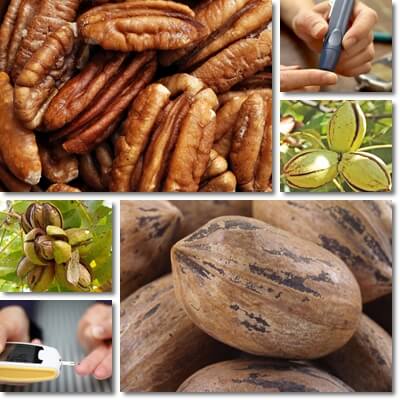You can definitely eat pecans if you have diabetes and don’t have to worry about them raising your blood sugar. Pecans are one of the best types of nuts a diabetic can eat with their condition because they are low in carbohydrates, high in fiber and extremely high in fat, nutritional aspects that favor blood sugar control, a key aspect for managing diabetes. And the main reason why pecans are good for diabetes is their low glycemic index score of only around 20, ranking as one of the lowest glycemic nut varieties. The only condition is to eat them in modest, reasonable amounts to avoid weight gain that could create complications for diabetes.
Pecans glycemic index: around 20 (low)
The glycemic index of pecans is currently undetermined, but presumed to be around 20, a very low value. There are also some that purport it to be 0, claiming eating the nuts produces little to no effects on blood sugar. The glycemic index (GI) is a scale that measures how fast the carbohydrates in a food raise blood sugar levels. Below 55 is a low GI. Between 56-69 is a moderate GI. Between 70-100 is a high GI. The lower the GI of a food, the lesser its impact on blood sugar. Diabetics and anyone looking to keep their levels under control should eat low GI foods as often as possible and avoid high GI foods to the best of their efforts.

How are pecans low-glycemic if their GI score hasn’t been determined in laboratory experiments (yet)? For the most part, the nutritional profile of pecans is comparable to that of other nuts with glycemic index scores of around 20. For example, pecans have as much carbs, sugar, fiber and protein as pistachios, peanuts, Macadamia nuts, almonds and other nuts with GI scores of around 20 and more fat than most nut varieties (almost as much as Macadamia nuts). Their nutritional profile is too similar to that of other varieties with fairly low GI’s for them to have wildly different glycemic effects.
Pecan nuts nutrition facts relevant for diabetes
Pecans are one of the lowest in carbs of all nut varieties, with only about 13.9 g of carbohydrates per 100 g. But most of that is dietary fiber, 9.6 g, and only about 4 g actual sugars. This means they provide only a little over 4 g of digestible carbohydrates that contribute towards blood sugar. Fiber is not really digestible and only serves to delay stomach emptying and slow down the rate of sugar absorption into the bloodstream. In other words, all that fiber you get from pecans is good for diabetes as it helps with blood sugar control.
Basically, the carbs that pecans do have consist mostly of fiber and very little sugar, strengthening the hypothesis of a GI as low as 20. At the same time, the nuts boast an extreme fat content of over 70 g of fat per 100 g and are a great source of protein with over 9 g per 100 g. Both fat and protein slow down sugar absorption into the bloodstream and further help stabilize blood sugar levels.

How many pecans a day can you eat with diabetes?
There isn’t a fixed number of pecans you can eat per day with diabetes. Foods affect people individually and diabetics may find they tolerate various foods differently. But while their blood sugar effects are fairly limited, the nuts are high in fat and calories (almost 72 g of fat and over 690 kcal per 100 g) and eating too much too often can easily cause weight gain which worsens diabetes. Common sense dictates eating about one ounce of pecans, a serving size equal to 28.35 g or about 19 halves.
An ounce should get you less than 4 g of carbohydrates, of which 2.7 g dietary fiber and only 1.1 g sugar. Given the limited carbohydrate intake, there isn’t much of a blood sugar rise you can except from this serving size. An ounce of pecans also gets you over 20 g of fat and 2.6 g of protein and 196 kcal.
As a diabetic, you can very well eat an ounce or two of pecans daily and enjoy the benefits without the risk of weight gain, provided you make good dietary choices overall. But if you usually fill up on fatty foods or high-calorie ones, then it may be a good idea to first remove or limit some of the less healthier foods in your to make room for healthier options like pecans. And keep active. Or else you risk weight gain which isn’t good for diabetes. Balance is important for getting good nutrition, achieving and maintaining a healthy weight and keeping your diabetes in check. Also see our list of 10 Low Glycemic Nuts and Seeds.
More about pecans and diabetes
If you are considering eating pecans for your diabetes, then it should help you to know how to better balance the nutrition they offer in order to get the most benefits from them and little to no side effects.
1) Remember to eat them in small portions of the likes of one ounce a day. Depending on your current weight, other dietary choices and level of physical activity, you may have them daily or infrequently. Consider their energetic value and high-fat content when establishing your intake. It could help to substitute other less healthy foods in your diet with healthier options like nuts and seeds.
2) Pecans don’t raise blood sugar. The reason they are one of the best nuts for diabetes is because they actually lower blood sugar. Eating them with other foods that are higher-glycemic than them helps lower the glycemic effects of those other foods and reduce the overall impact on blood sugar of the entire meal. Try having some pecans with a serving of a fruit.
3) Pecans are low-carbohydrate, low-sugar, high-fiber, moderate-protein and high-fat. All of these aspects of nutrition favor a low glycemic index and defend the score proposed (around 2o). The topic will be updated as soon as there is official information regarding the glycemic index of pecans.
4) The glycemic load of pecans is presumed to be 0 (zero). The glycemic load (GL) measures how fast the carbohydrates in a serving of a food raise blood sugar levels. Given that a serving of pecans is only one ounce (28.35 g or 19 halves) and provides a little over 1 g of digestible carbohydrates (but over 20 g of fat, 2.6 g of protein and 2.7 g of dietary fiber which compensate for the glycemic effects of the digestible carbohydrates), effects on blood sugar are expected to be minimal.
5) It helps to exercise. High-calorie foods require regular exercise to avoid weight gain. So no matter how healthy pecans or other nuts are, know they have the potential to cause weight gain. In addition to eating them reasonably, it helps to exercise too.
6) Avoid salted, sweetened or candied pecans. The benefits for diabetes apply only for the raw, fresh or dried nuts. Salt runs blood pressure up. Sweeteners raise blood sugar and add calories to your diet, whether it’s table sugar, honey or corn syrup. Candied options take away from the benefits of the nuts and their nutrition.
